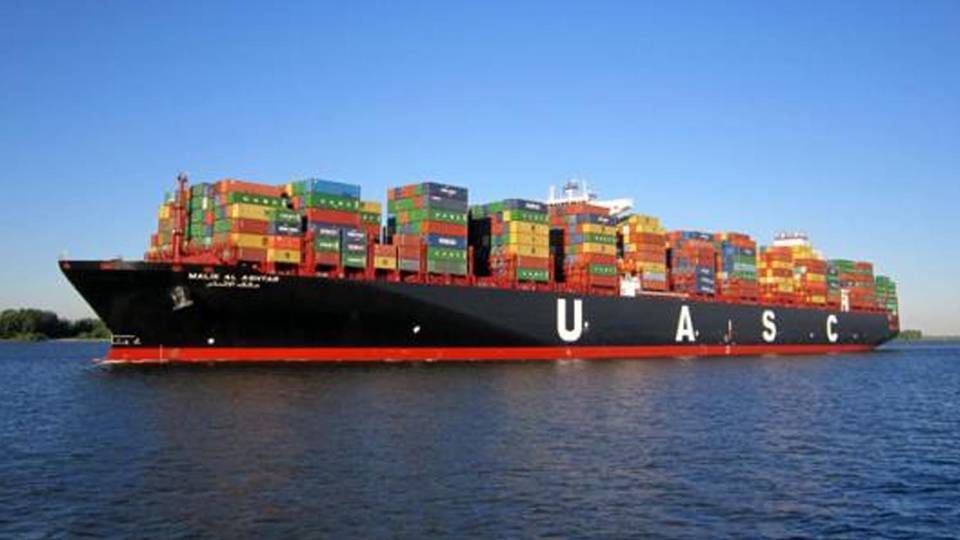Jørn Hinge: New fleet will strengthen us globally

A farily solid infrastructure in the Middle East, where several ports such as Jebel Ali in Dubai are equipped to handle the new, massive container ships serves as a key contributing factor in United Arab Shipping Company's decision to sign an order on Thursday for a series of ultra large container ships from Korean Hyundai Heavy Industries, an order that will begin with five 18,800 teu unites and five 14,500 teu units. But the shipping company will also become more global, says CEO Jørn Hinge in an interview with ShippingWatch.
"There will be two ports in the Middle East, Jebel Ali and Khor Fakkan in the Gulf of Oman, capable of handling 18,000 teu ships, and massive ships are currently calling in, for instance, Jebel Ali for many carriers trading on Asia-Europe. And when there's not enough cargo there, they sail in and pick up cargo to and from the Middle East. We've started to feel this effect negatively, which is why we need to be able to compete with shipowners operating with the lower unit costs created by the massive ships," says Jørn Hinge:
Need for more efficient ships
"Our biggest ships today are 13,500 teu, but those ships were purchased when the market was strong, and they can sail at more than 25 knots. But they're also consuming so much oil that we'll never be able to afford sailing at those speeds again. In liner shipping, it's all about having low unit costs, and one way to get that is by using bigger, more efficient ships. We're now trying to achieve both with these 18,800 and 14,500 teu ships, and we're getting some ships that consume significantly less energy. And as far as I know, our new ships will be the first ones ready to sail on liquid natural gas, LNG. We've done everything that can be done today, and which is both expensive and difficult, to one day be able to use LNG on the ships," says Jørn Hinge.
Arabian UASC wants to beat Maersk's mega ships
The new container ships will need bigger tanks in order to sail on LNG, but according to Jørn Hinge, that conversion can be done in a few weeks:
"I expect that the necessary LNG infrastructure will be available in 3-5 years, and we'll also be ready by then."
Rebranding UASC services
Ever since UASC hinted that the carrier was considering investments in new, bigger tonnage similar to that of many other carriers, international shipping analysts have pointed to the fact that a massive fleet expansion would surpass the shipping company's current needs. But according to Jørn Hinge, there's going to be a significant change to the number of chartered ships, especially in the 4,000 - 5,000 teu segment, that will be returned to their owners, as the ships are much more expensive to operate today. Additionally, there will be a complete rebranding of the way the carrier operates its services.

UASC's new and bigger units will gradually make the carrier more international. And the reason why UASC "only" ordered five 18,000 teu ships so far is tied to a new joint service with China International Container Lines (CSCL).
"The Middle East is our key market, but of course we're trying to connect our fleet to other trades, and we're becoming increasingly global, which means we're not just sailing to and from the Middle East, like we did in the old days. The fact is that the Middle East is placed between Europe and Asia. If we were to be an exclusively Middle Eastern carrier, we could be sailing 5,000 - 6,000 teu ships, but the situation today is that several ports in the Middle East can handle the ultra large ships that many carriers are using," says Jørn Hinge.
In addition to jebel Ali and Khor Fakkan, Khalifa Port in Abu Dhabi and Salalah in the southern part of Oman are also capable of handling massive containcer ships.
Not worried about P3
This spring, Jørn Hinge announced that United Arab Shipping Company, in relation to a new recruitment program and the promotion and hiring of two former Maersk executives in the senior management, Uffe Østergaard as Chief Commercial Officer and Lars Christiansen as Chief Trade Officer, was facing a transformation process and a completely new operating model. At the time, he also pointed to the fact that the carrier was preparing a significant change based on new capacity that was underway in the form of a comprehensive newbuilding program, and since then, leading container analysts have been speculating intensely about the Arabian carrier's ambitions and strategy.
Former Maersk executives in top positions at Arabian carrier
During 2013, the organization has hired around 100 new employees, says Jørn Hinge, who isn't concerned about the discussion of whether USAC, with the new fleet expansion from 2014 and on, harbors ambitions about securing a bigger market share among the world's 20 largest container carriers.
"It's more important for us to be able to deliver solid financial results, and we hope we'll be to do that with ships that are more competitive," says Jørn Hinge, who doesn't seem particularly worried about the new and much bigger concentration on Asia-Europe that would follow if the competitive authorities approve the new P3 alliance between Maersk Line, MSC, and CMA CGM, the three largest carriers in the world.
"I hope it'll have a positive effect on the market. I assume the three carriers aren't joining forces because they're friends, but because they want to make some more money. So I hope this will stabilize the market and have a positive effect for the rest of us as well," says Jørn Hinge.
The contract for the 10 ships amounts to a total of approximately USD 1.3 billion. If the carrier uses the accompanying options, the figure becomes around USD 2 - 2.5 billion.
Related articles
APL: We're caught in a mega ship dilemma
For subscribers

.jpg)
.jpg)

















